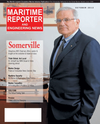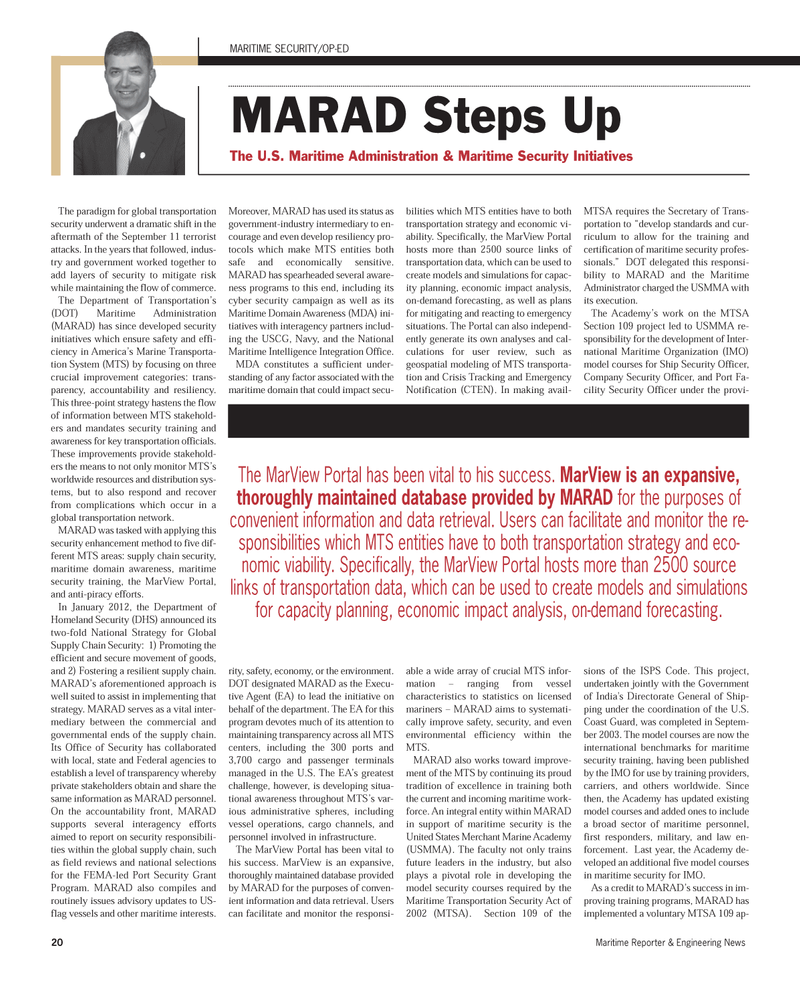
Page 20: of Maritime Reporter Magazine (October 2012)
Marine Design & Construction
Read this page in Pdf, Flash or Html5 edition of October 2012 Maritime Reporter Magazine
20Maritime Reporter & Engineering News The paradigm for global transportationsecurity underwent a dramatic shift in theaftermath of the September 11 terroristattacks. In the years that followed, indus- try and government worked together to add layers of security to mitigate risk while maintaining the flow of commerce. The Department of Transportation?s (DOT) Maritime Administration (MARAD) has since developed security initiatives which ensure safety and effi- ciency in America?s Marine Transporta- tion System (MTS) by focusing on threecrucial improvement categories: trans- parency, accountability and resiliency. This three-point strategy hastens the flow of information between MTS stakehold- ers and mandates security training andawareness for key transportation officials. These improvements provide stakehold- ers the means to not only monitor MTS?s worldwide resources and distribution sys- tems, but to also respond and recover from complications which occur in aglobal transportation network. MARAD was tasked with applying this security enhancement method to five dif- ferent MTS areas: supply chain security, maritime domain awareness, maritime security training, the MarView Portal, and anti-piracy efforts. In January 2012, the Department ofHomeland Security (DHS) announced itstwo-fold National Strategy for Global Supply Chain Security: 1) Promoting theefficient and secure movement of goods, and 2) Fostering a resilient supply chain. MARAD?s aforementioned approach is well suited to assist in implementing thatstrategy. MARAD serves as a vital inter- mediary between the commercial andgovernmental ends of the supply chain. Its Office of Security has collaborated with local, state and Federal agencies toestablish a level of transparency whereby private stakeholders obtain and share the same information as MARAD personnel.On the accountability front, MARADsupports several interagency efforts aimed to report on security responsibili-ties within the global supply chain, suchas field reviews and national selections for the FEMA-led Port Security GrantProgram. MARAD also compiles androutinely issues advisory updates to US-flag vessels and other maritime interests. Moreover, MARAD has used its status as government-industry intermediary to en- courage and even develop resiliency pro- tocols which make MTS entities both safe and economically sensitive. MARAD has spearheaded several aware- ness programs to this end, including itscyber security campaign as well as its Maritime Domain Awareness (MDA) ini- tiatives with interagency partners includ- ing the USCG, Navy, and the National Maritime Intelligence Integration Office. MDA constitutes a sufficient under- standing of any factor associated with the maritime domain that could impact secu-rity, safety, economy, or the environment. DOT designated MARAD as the Execu- tive Agent (EA) to lead the initiative on behalf of the department. The EA for this program devotes much of its attention to maintaining transparency across all MTS centers, including the 300 ports and3,700 cargo and passenger terminals managed in the U.S. The EA?s greatest challenge, however, is developing situa- tional awareness throughout MTS?s var- ious administrative spheres, including vessel operations, cargo channels, and personnel involved in infrastructure. The MarView Portal has been vital to his success. MarView is an expansive, thoroughly maintained database provided by MARAD for the purposes of conven- ient information and data retrieval. Users can facilitate and monitor the responsi- bilities which MTS entities have to both transportation strategy and economic vi- ability. Specifically, the MarView Portal hosts more than 2500 source links oftransportation data, which can be used tocreate models and simulations for capac-ity planning, economic impact analysis,on-demand forecasting, as well as plansfor mitigating and reacting to emergency situations. The Portal can also independ- ently generate its own analyses and cal- culations for user review, such as geospatial modeling of MTS transporta-tion and Crisis Tracking and Emergency Notification (CTEN). In making avail- able a wide array of crucial MTS infor- mation ? ranging from vessel characteristics to statistics on licensedmariners ? MARAD aims to systemati-cally improve safety, security, and even environmental efficiency within the MTS.MARAD also works toward improve- ment of the MTS by continuing its proudtradition of excellence in training both the current and incoming maritime work- force. An integral entity within MARAD in support of maritime security is theUnited States Merchant Marine Academy (USMMA). The faculty not only trains future leaders in the industry, but also plays a pivotal role in developing the model security courses required by theMaritime Transportation Security Act of 2002 (MTSA). Section 109 of theMTSA requires the Secretary of Trans- portation to ?develop standards and cur- riculum to allow for the training and certification of maritime security profes- sionals.? DOT delegated this responsi- bility to MARAD and the MaritimeAdministrator charged the USMMA with its execution. The Academy?s work on the MTSA Section 109 project led to USMMA re-sponsibility for the development of Inter- national Maritime Organization (IMO) model courses for Ship Security Officer, Company Security Officer, and Port Fa- cility Security Officer under the provi- sions of the ISPS Code. This project, undertaken jointly with the Government of India's Directorate General of Ship-ping under the coordination of the U.S.Coast Guard, was completed in Septem- ber 2003. The model courses are now the international benchmarks for maritimesecurity training, having been published by the IMO for use by training providers, carriers, and others worldwide. Since then, the Academy has updated existing model courses and added ones to includea broad sector of maritime personnel,first responders, military, and law en- forcement. Last year, the Academy de- veloped an additional five model courses in maritime security for IMO.As a credit to MARAD?s success in im- proving training programs, MARAD has implemented a voluntary MTSA 109 ap- MARITIME SECURITY/OP-EDMARAD Steps UpThe U.S. Maritime Administration & Maritime Security InitiativesThe MarView Portal has been vital to his success. MarView is an expansive, thoroughly maintained database provided by MARAD for the purposes ofconvenient information and data retrieval. Users can facilitate and monitor the re- sponsibilities which MTS entities have to both transportation strategy and eco- nomic viability. Specifically, the MarView Portal hosts more than 2500 source links of transportation data, which can be used to create models and simulations for capacity planning, economic impact analysis, on-demand forecasting. MR#10 (18-25):MR Template 10/2/2012 10:40 AM Page 20

 19
19

 21
21
